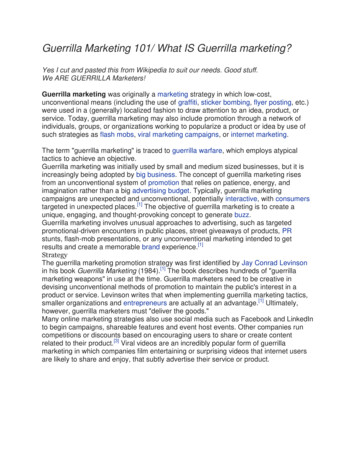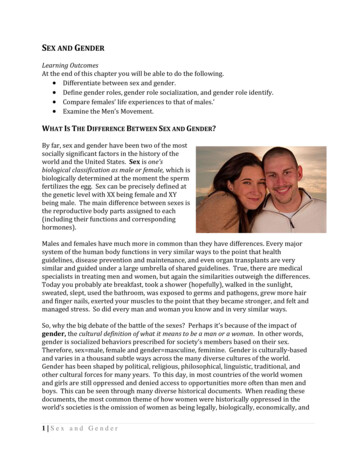
Transcription
Guerrilla GirlsThe Guerrilla Girls: Art, Gender, and CommunicationMaria Hanson1
Guerrilla Girls2In her introduction to Global Feminisms: New Directions in Contemporary Art, MauraReilly asks, “In an era that postdates the women’s and civil rights movements, how can a curatororganize an international contemporary art exhibition that includes almost exclusively EuroAmerican male artists?”1 This is the same question that the Guerrilla Girls, a collective ofanonymous female artists, pose to the public through their work. By producing posters, books,and performances, the Guerrilla Girls achieve their the goal of “exposing acts of sexism andracism in politics, the art world, film, and culture at large.”2 I argue that the group’s method ofexaggerating the rhetorical strategies used to propagate the normalcy of male domination in theart world translate well to their critiques of popular and political culture, and that this method isan important aspect of feminist discourse today. I will explore the history of the Guerrilla Girlsand the reasons for their work, as well as the ways in which they have transcended the topic ofart in order to provide a compelling critique of broader societal attitudes towards women.The Guerrilla Girls’ work helps to answer questions about what the possibilities andmanifestations of third wave feminism can be. They incorporate aspects of current feminist focussuch as the intersectionality of race, class, and gender, as well as a desire to use new tactics toreach a wider audience through social media, television, and art. In contrast with the secondwave of feminism in the 1960s and 70s, Shugart, Waggoner, and Hallstein describe the thirdwave as more focused on difference, empowerment through individualism, embracing sexualdesire, and embeddedness in popular culture. They say it is also defined in opposition to thesecond wave, which many perceive as ignorant of the needs of those who were not white,1Reilly, Maura, and Linda Nochlin. "Introduction: Toward Transnational Feminisms."Global Feminisms:New Directions in Contemporary Art. London: Merrell, 2007, 22.2"Guerrilla Girls: Fighting Discrimination with Facts, Humor and Fake Fur." Guerrilla Girls: FightingDiscrimination with Facts, Humor and Fake Fur. Web. 09 May 2012.
Guerrilla Girls3middle-class, and heterosexual women.3 Anita Harris discusses the decline in the familiarfeminist of the 1960’s and ‘70’s in her article, “Mind the Gap.” She says that young womentoday are just as concerned about issues of equality as were their counterparts fifty years ago,feel more able to create their own narrative in order to define feminism instead of simplyidentifying as victims of a patriarchal society. They are more likely to participate in alternative,more culturally oriented forms of political action, such as public street parties, blogs, and artsactivism. Harris argues that accepting these new forms of activism is what will move feminismforward. “What is required, I think,” says Harris, “is an openness in our ideas about whatconstitutes feminist politics today such an approach might enable us to yet move beyondgenerationalism to forge a ‘new feminism’ we do not yet know”.4 The Guerrilla Girls’ strategiesfurther the aims of contemporary feminism in a way that promotes real change, especially forwomen who are artists but also for anyone who views art and even images in popular culture.The covert artists espouse these characteristics by using things like posters to inform viewersabout continuing inequality and appropriating images that are recognizable to their audiences.It is also important to note the Guerrilla Girls’ work calls attention to societal issues ofrace, political discourse, and reproductive health, attempting to address the intersectional natureof feminism. However, because the group’s primary concern is women in museum culture andart, I will mainly focus on this area of their work, using one example of their work that does notdeal with fine art specifically and two that do.3Shugart, Helene, Catherine Egley Waggoner, and D. Lynn O'Brien Hallstein. "Mediating Third-waveFeminism: Appropriation as Postmodern Media Practice." Critical Studies in Media Communication 18.2 (2001),1954Harris, Anita. “Mind The Gap.” Australian Feminist Studies 25.66 (2010): 475. MasterFILE Premier.Web. 8 Feb 2012.
Guerrilla Girls4Despite the gains made by women in many areas, including art, during the past severaldecades, there is ample evidence to show that men are still the dominant players in the field by awide margin. In 1984, the Museum of Modern Art in New York held an exhibition titled AnInternational Survey of Recent Painting and Sculpture, marketed as a current summary of themost significant contemporary art in the world. Not only were a mere 13 of the 169 artists in theshow were women, the exhibition’s curator said that any artist who wasn’t in the show shouldrethink ‘his’ career.5 This event sparked the curiosity of several women artists, who did researchon the representation of women in galleries and museums. Their findings were upsetting enoughto inspire the group’s first posters, which exposed the discrepancies perpetuated by art dealers,collectors, and critics.6Since the Guerrilla Girl’s inciting event, the art world has continued in many ways toenforce the dominance of men. It has only been 24 years since H.W. Janson’s History of Art, thestandard text for college art history classes, thought to include any women in its examination of2,300 artists. In 1986, 24 years after it was first published in 1962, 19 women were added tothese thousands of men. In exhibitions, too, women are vastly underrepresented. After itsextensive expansion in 2004, the Museum of Modern Art in New York featured 410 works in its4th and 5th floor galleries, where painting and sculpture are exhibited. Only 16 of those workswere by women.7 The problem continues: on a poster from their March 2012 exhibition atColumbia College in Chicago, the Guerrilla Girls stated that the 90 percent of the artists whosework is displayed in the Art Institute of Chicago’s Modern galleries are male.8 Not onlymuseums, but galleries also fail to feature female artists. In 2005, only 32 percent of artists5Reilly, 22"Guerrilla Girls: Fighting Discrimination with Facts, Humor and Fake Fur."7Reilly, 198"Guerrilla Girls: Fighting Discrimination with Facts, Humor and Fake Fur."6
Guerrilla Girls5represented 50 New York City galleries surveyed were women, and just 17 percent of the soloshows in New York galleries were by women.9 Similar imbalances exist across the globe, as theGuerrilla Girls have made known through poster and letter campaigns in countries other than theUnited States, including Italy, the Netherlands, Canada, China, Greece, Ireland, England,Turkey, Spain, and Mexico.10Failing to represent women in galleries is especially troubling because of the effects it hason those women as working professionals. It results in less recognition through press coverage,leading to lower interest from collectors and museums, making art made by women carry lowermarket and monetary value. The difference between the price of a work made by a womanversus one by a man, says Reilly, citing a 2005 investigation by New York Times reporter GregAllen, can be “tenfold or more.”11 The Guerrilla Girls summed up this problem in a sentence ontheir 1989 poster, “The Advantages of Being a Woman Artist,” one sarcastically stated perkbeing that these women have “an escape from the art world in your 4 free-lance jobs.”12The Guerrilla Girls and their tactics are worth exploration as agents of feminist change –their work has been translated into more than eight different languages and praised by figuressuch as Gloria Steinem and Yoko Ono. They have even been recognized by their inclusion inmuseum and gallery exhibitions, and they have existed as a group since 1985. While theGuerrilla Girls have received little scholarly attention, according to Anne Demo, they have beena model for grassroots movements and feminists in a time when there is a call for “increasedcritical attention to nontraditional forms of feminist rhetoric.”13 Steinem says that the Guerrilla9Reilly, 20"Guerrilla Girls: Fighting Discrimination with Facts, Humor and Fake Fur."11Reilly, 2112"Guerrilla Girls: Fighting Discrimination with Facts, Humor and Fake Fur."13Demo, Anne Teresa. "The Guerrilla Girls' Comic Politics of Subversion." Visual Rhetoric: A Reader inCommunication and American Culture. By Lester C. Olson, Cara A. Finnegan, and Diane S. Hope. Los Angeles:Sage, 2008, 24210
Guerrilla Girls6Girls are a “group that symbolized the best of feminism in this country . . . Smart, radical, funny,creative, uncompromising, and (I assume) diverse under those inspired gorilla masks, they forceus to rethink everything from art to zaniness.”14 Appreciation for this ‘zaniness’ from fellowfeminists is evidence that the Guerrilla Girls represent what at least a portion of the group inopposition to the forces that control the art world wants to see, lending further justification to theidea of studying the group and the ways in which they communicate.One of the Guerrilla Girls’ primary modes of communicating is through exaggerateddiscourse aimed at mimicking the rhetoric of established institutions in order to call attention tosocietal problems. This idea is evident in the group’s name, which includes the reclamation ofthe word “girl,” often connoted with the idea of immaturity or incompleteness. Anne Demopoints to this idea in her essay on the Guerrilla Girls, saying, “Reclamation of the term ‘girl,’ aswell as all things girlish, demonstrates how mimicry functions as a strategy of incongruity.”15Using a label with a negative connotation juxtaposed with the Guerrilla Girls’ call to attention ofthe ways in which women do not exemplify those ideas has the effect of distancing the wordfrom those connotations. When asked if labeling themselves ‘girls’ stands in contradiction totheir feminist politics, Guerrilla Girl Frida Kahlo (a pseudonym; the Guerrilla Girls often concealtheir identities not only with masks but by using the names of female artists) explained, “Callinga grown woman a girl can imply she’s not complete, mature, or grown up. But we decided toreclaim the world ‘girl,’ so it couldn’t be used against us.”16 The Guerrilla Girls’ mimicry ofrepresentations of what is feminine in the art world as well as in popular culture continues intheir posters.14Demo, 243Demo, 24616Demo, 24615
Guerrilla Girls7Maximum Exposure17“How Women Get Maximum Exposure in Art Museums” was the Guerrilla Girls’response to a request in 1989 from the Public Art Fund in New York to design a billboard thatwould appeal to a general audience. The headline of the poster reads, “Do women have to benaked to get into the Met. Museum?” and underneath, “Less than 5% of the artists in the ModernArt sections are women, but 85% of the nudes are female.”18 Beside the text is a reclining nudewoman wearing a gorilla mask with disproportionately large teeth and holding a fan that isdistinctly phallic. The woman is an appropriation of Auguste Dominique Ingres’s 1814 paintingGrand Odalisque, the gorilla mask similar to those worn by Guerilla Girls during appearances inpublic to hide their identities. The advertisement for the Met’s exclusionary exhibiting practicesultimately appeared on busses instead of billboards – The Public Art Fund rejected the designwith the reasoning that it was not clear enough. The Guerrilla Girls instead rented ad space onNew York busses until the company canceled their lease due to the opinion that the image of theOdalisque and the phallic fan were too suggestive.1917“How Women Get Maximum Exposure in Art Museums,” 1989.“How Women Get Maximum Exposure in Art Museums”19"Guerrilla Girls: Fighting Discrimination with Facts, Humor and Fake Fur."18
Guerrilla Girls8This piece exaggerates the role of women in the art world through the appropriation of awell-regarded historical work and through the colors of the poster. “How Women Get MaximumExposure in Art Museums” uses the image of Ingres’ Odalisque to comment on the long historyof the female nude in Western art as a subjugating theme, with a man’s perspective or the ‘malegaze’ being the prevailing viewpoint in art. John Berger describes this history and its impact onwomen, saying, “In one category of European oil painting women were the principal, everrecurring subject. That category is the nude. In the nudes of European painting we can discoversome of the criteria and conventions by which women have been seen and judged as sights.”20Nudity, Berger posits, is related not only to two-dimensional paintings but also to livedsexuality.21 Nakedness is an expression of oneself, he says, whereas nudity is different in that itobjectifies bodies, therefore nudity grants the viewer power and agency. “To be nude is to beseen naked by others and yet not recognized for oneself,” Berger says. “A naked body has to beseen as an object in order to become a nude. (The sight of it as an object stimulates the use of itas an object.) Nakedness reveals itself. Nudity is placed on display in the average European oilpainting of the nude the principal protagonist is never painted. He is the spectator in front of thepicture and he is presumed to be a man.”22 The man’s gaze is active, whereas the pose of thenude is typically passive, turning toward the viewer with a downcast or indirect glance from thesubject, allowing the viewer to examine the feminine physique as he pleases. The nude facing theviewer is significant, according to Sturken and Cartwright, because it invites the male spectatorto take possession of the image and the woman. “The act of looking,” they say, “is commonly20Berger, John. "3." Ways of Seeing. London: Penguin, 2008, 47Berger, 5322Berger, 5421
Guerrilla Girls9regarded as awarding more power to the person who is looking than to the person who is theobject of the look.”23The Guerrilla girls, however, cover the face of the figure with the face of an aggressivelooking gorilla. “In covering the face of the model, or odalisque, with the gorilla mask, theseartist-activists are quite pointedly refusing to look back at the spectator” (Sturken and Cartwright123). The Guerrilla Girls’ Odalisque also refuses passivity in her pose by brandishing a fan thathas been modified from Ingres’ version with the omission of the detailing on the handle and theaddition of a sack-like shape on top to make it resemble an erect penis. Replacing the passiveface and pose with these elements gives the figure agency – actively brandishing teeth andgripping a ‘fan.’ Discussing representations of the female body, Sturken and Cartwright say,“The values and meanings of signifiers reproduced in these generic codes have become soembedded in the culture as to seem as if they are natural and unmediated.”24 Using the nude,something viewers expect to see in art, in an exaggerated way allows Guerrilla Girls to exposewhat is problematic about it and to show an alternative. They also exaggerate the idea ofsexuality in regards to the nude, taking control of it without denouncing it entirely.The poster also uses the stereotypically ‘feminine’ colors pink and yellow, but useshighly saturated hues instead of the more calm and muted tones associated with peacefullyreclining women. Like using the term ‘girl,’ the bright yellow background and pink text is anaction of reclamation. Paired with a snarling gorilla head, the colors become abrasive andattention grabbing. Such mimicry is, as Demo says, “exposing the harms of norms without beingreduced to them.”2523Sturken and Cartwright, 111Sturken and Cartwright, 11925Demo, 24624
Guerrilla Girls 10Exposing the harms of societal norms is increasingly important today, not only in the artworld, but also in popular society and political discourse. As male politicians assume controlover women’s reproductive health rights, and women conform to magazine cover standards byputting feeding tubes through their noses as a way to diet, it is apparent that feminist goals ofequality have not yet been reached. The Guerrilla Girls are also a voice outside of the arena ofart, and have been making posters calling out politicians, the film industry, and perpetuators ofstereotypes that negatively affect women since1991.26The Birth of Feminism27One such poster, “The Birth ofFeminism,” deals with representations ofwomen in media and film. In 2001, theGuerrilla Girls responded to calls fromfilmmakers for a movie about the history offeminism by imagining how Hollywood mightinterpret this story. The result was a postermade to look like a movie advertisement withthe characteristic yellow background and pink lettering of Guerrilla Girls’ art posters. It featuredPamela Anderson, Halle Berry, and Catherine Zeta-Jones, all scantily clad and holding a banneracross their hips that read “Equality Now!” Below the banner, each woman’s name appears,2627"Guerrilla Girls: Fighting Discrimination with Facts, Humor and Fake Fur."“The Birth of Feminism,” 2001.
Guerrilla Girls 11followed by the names of the three American feminists they would portray in the imaginary film:Gloria Steinem, Flo Kennedy, and Bella Abzug. “They made women’s rights look good. Reallygood” says the caption below. Above the women’s’ heads the text reads, “A Major HollywoodStudio presents: The Birth of Feminism,” with the first portion in a script-like font, followed bythe bold letters of “birth” and “feminism,” and “the” and “of” in a bubbly typeface.28Like “How Women Get Maximum Exposure in Art Museums,” this poster uses a popularimage of sexuality, three women widely recognized at the time for their physiques and theirsuccess in Hollywood, posed in a way that both highlights their bodies and resembles a commonmovie poster. By mimicking popular representations of femininity, the Guerrilla Girls show thelack of importance or misunderstanding of feminist issues in popular culture. The incongruitybetween the actresses and the women they would represent in the movie emphasizes thediscrepancy between the reality and expectations of women in society. Pamela Anderson, forinstance, has become globally recognized for her body since her role in Baywatch, and has beenphotographed for Playboy magazine 12 times. Gloria Steinem, on the other hand, founded Ms.Magazine and worked as a bunny in New York’s Playboy Club to investigate the workingconditions for young women in Hugh Hefner’s empire.29 The poster tweaks common imagery tocomment on society’s insistence on a certain image of women without simply castigating thatimage.On the other hand, this poster can be read in a way that opens a newer kind of discoursethat calls into question outdated assumptions about feminists and their protests of sexualizedrepresentations of women’s bodies. The Guerrilla Girls’ website implies that the poster is criticalof women like Anderson, Berry, and Zeta-Jones, and it is necessary to consider the impact of2829“The Birth of Feminism”"Guerrilla Girls: Fighting Discrimination with Facts, Humor and Fake Fur."
Guerrilla Girls 12reducing these women, who have been highly successful in their careers, to emblems of idealsthat are incongruous with those of feminism. A reading like this brings to mind the MissAmerica Pageant protest in 1968, which is recognized as a catalyst for the second wave of thefeminist movement, and has influenced popular perceptions of feminism since. Those feministsargued that the pageant depicted women as submissive, posing in bathing suits for theamusement of male viewers.30 Today these events are billed as “scholarship pageants,” and placean emphasis on the agency of the contestants by discussing the professional ambitions andcompetitive qualities of the contestants.31 Similarly, a more complex reading of the GuerrillaGirls’ poster and the sexuality that it portrays might take into account the agency that thesewomen display by having lucrative careers in the acting business and sometimes choosing towear revealing clothing as a part of this career. Juxtaposing thin, scantily clad women with thenames of feminist intellectuals in the way that the Guerrilla Girls intend in this piece works toundermine the idea that feminism should be collaborative. Rather than positioning some types ofwomen as working against others and propagating the idea that only women who are notinvested in their appearance in conventional ways can participate in feminism is antithetical to itsgoals of equality and partnership; we should strive to be inclusive for the purpose of supporting acommon cause.Despite the shortcomings in the message from “The Birth of Feminism,” the GuerrillaGirls are an integral contributor to the feminist cause in 21st century America. As advocates forfeminism in art, the Guerrilla Girls bring a tactic of resistance that fits the current mood insociety, and as advocates for equality in general, they critique harmful norms in a way that callsattention to them through mimicry. Feminism is coming to encompass an increasingly broad set30Dow, Bonnie J. "Feminism, Miss America, and Media Mythology." Rhetoric & Public Affairs 6.1(2003), 12831Dow, 142
Guerrilla Girls 13of issues in contemporary society. This combined with a stigma of the term seems to be thediffusion of action or organization and a rejection of the idea that radical demonstration isnecessary. The Guerrilla Girls’ eye-catching activism may be part of this new feminism, as itencourages thought and analysis about culture in a way that Harold compares to MichelFoucault’s observations on political action. “Rather than using political action to discredit a lineof thought (as the parodist might have it), Foucault urges us to ‘use political practice as anintensifier of thought, and analysis as a multiplier of the forms and domains for the interventionof political action.’”32 While Guerrilla Girl-style sarcasm and poster-making do not need to bethe only forms of activism or critique, they are especially well suited to the complex, varied, andindividual attitudes toward feminism today in that they do not force a single answer or even theidea that change and current ideas are mutually exclusive.While the Guerrilla Girls’ works seem to be the right avenue for promoting a shift inattitudes in the art establishment, have they actually made a difference? Continuing genderdisparities in art would lead some to answer no, that the group may have prompted thought butnot action. In 2004, Guerrilla Girls did a count identical to their 1989 survey of the MetropolitanMuseum of Art and found that not a lot had changed. While the percentage of female nudes haddropped slightly from 85 to 83 percent, the percentage of female artists in the Modern Artsections had also dropped from less than five percent to less than three percent. For the 2005Venice Biennale, the Guerrilla Girls released a poster identical to their 1989 version but withupdated statistics. These numbers, along with the disheartening facts that the monetary value ofwomen’s artwork is still far lower than men’s and women curators are rarely invited to organizethe more prestigious international exhibitions, are not optimistic. In addition, the current32Harold, Christine. "Pranking Rhetoric: “culture Jamming” as Media Activism." Critical Studies in MediaCommunication 21.3 (2004), 208
Guerrilla Girls 14conversation about women’s reproductive health points toward an unhealthy attitude in societyabout women and their ability to make decisions about their lives. However, the Guerrilla Girlswork has been received in a way that shows a shift towards equality, albeit a slow one.The Guerrilla Girls’ recognition by popular media and inclusion within the artestablishment is one indicator of their success in promoting thoughtful change. In addition toinclusion in major media publications, members of the group were invited to speak at thecommencement address for the School of the Art Institute of Chicago in 2009. The same year,the group spoke at MoMA’s “Feminist Future Symposium,” discussing activism, race, andgeopolitics.33 The event brought the Guerrilla Girls to the very museum that inspired the group’soriginal members to start their work; it is a significant sign of success that collaboration is able tooccur between this establishment and some of its most outspoken critics.33"Guerrilla Girls: Fighting Discrimination with Facts, Humor and Fake Fur."
Guerrilla Girls 15Gender Reassignment34More than two decades after “How Women Get Maximum Exposure in Art Museums,”the Guerrilla Girls continue to create new work. In their 2012 work, “Guerrilla Girls toMuseums: Time for Gender Reassignment,” the women tell museums that it is “Time for genderreassignment!” in bold letters over a photograph of a museum bearing the recognizable names ofmale renaissance artists such as Donatello and Botticelli. Flying out of the clouds above thebuilding are winged gorillas and angels, or putti, also of renaissance popularity. The gorillas holdpink banners with names in lettering identical to that of the names on the museum, but thebanners hold the names of female artists: Artemisisa Gentileschi, Frieda Kahlo, Edmonia Lewis,34“Guerrilla Girls to Museums: Time for Gender Reassignment,” 2012.
Guerrilla Girls 16Rosa Bonheur, and Alma Thomas. The collaged photograph appears to be ripped aside, showinga collection of statistics about Art Institute of Chicago, including the percentages of male artistsin its Contemporary and Modern galleries. The bottom corner reads, “Time to do what Paris,London, Madrid, and Stockholm are doing: collect and exhibit more art by women!”35This poster is more explicit than past works in its suggestions for alternatives to the statusquo. “Many museums have names of famous artists inscribed on their facades. None arewomen,” says to the point at the top of the poster’s list of objections to museum practices.Solving this problem could be as simple as placing a banner over inscriptions of male artists’names, as the flying gorillas show with their banners that seem to be made to fit over Da Vinciand Michelangelo’s names. On their website, Guerrilla Girls reveal that they would actually liketo be able to translate the picture to life. “Now that we’ve done the poster version, we’re ready todo it for real by putting temporary banners on some museum façade. If any curator out therewants to step up and let us perform this sex change operation on their museum, please let usknow,” says the caption.36The Guerrilla Girls provide part of the answer to questions regarding the direction offeminism and equality today. Their success in the art world has led them to gain a voice alsoheard in the broader context of popular culture, and is an important model for the possibilitiesthat can come of creative ways to promote feminist ideals in an era when disconnect and apathyare often seen as more common than organization and passion. By using recognizable imagesand exaggerating or changing them, the group catches viewers’ eyes and provides easilyunderstandable information that asks the public to examine their assumptions. They avoidalienating viewers by using humor and by not specifically calling for an end to current norms,3536“Guerrilla Girls to Museums: Time for Gender Reassignment”"Guerrilla Girls: Fighting Discrimination with Facts, Humor and Fake Fur."
Guerrilla Girls 17but for alternate versions of them. Through this work, the Guerrilla Girls have opened upconversations about gender and equality in both the art world and in the rest of society.
Guerrilla Girls 18Works CitedBerger, John. "3." Ways of Seeing. London: Penguin, 2008. Print.Demo, Anne Teresa. "The Guerrilla Girls' Comic Politics of Subversion." Visual Rhetoric: AReader in Communication and American Culture. By Lester C. Olson, Cara A. Finnegan,and Diane S. Hope. Los Angeles: Sage, 2008. 241-54. Print.Dow, Bonnie J. "Feminism, Miss America, and Media Mythology." Rhetoric & PublicAffairs 6.1 (2003): 127-49. Print.Et. Alia, "Gertrude Stein." "Guerrilla Girls and Guerrilla Girls BroadBand: Inside Story."ArtJournal 70.2 (2011)."Guerrilla Girls: Fighting Discrimination with Facts, Humor and Fake Fur." Guerrilla Girls:Fighting Discrimination with Facts, Humor and Fake Fur. Web. 09 May 2012.Harold, Christine. "Pranking Rhetoric: “culture Jamming” as Media Activism." Critical Studiesin Media Communication 21.3 (2004): 189-211. Print.Harris, Anita. “Mind The Gap.” Australian Feminist Studies 25.66 (2010): 475. MasterFILEPremier. Web. 8 Feb 2012."Metropolitan Museum of Art, New York." Web Gallery of Art. Web. 10 May 2012.Raizada, Kristen. "An Interview with the Guerrilla Girls, Dyke Action Machine (DAM!), and theToxic Titties." NWSA Journal 19.1 (2007): 39-58.Reilly, Maura, and Linda Nochlin. "Introduction: Toward Transnational Feminisms."GlobalFeminisms: New Directions in Contemporary Art. London: Merrell, 2007. 15-43. Print.
Guerrilla Girls 19Shugart, Helene, Catherine Egley Waggoner, and D. Lynn O'Brien Hallstein. "Mediating Thirdwave Feminism: Appropriation as Postmodern Media Practice." Critical Studies in MediaCommunication 18.2 (2001): 194-210. Print.Sturken, Marita, and Lisa Cartwright. Practices of Looking: an Introduction to Visual Culture.2nd ed. Oxford: Oxford UP, 2009. Print.
reach a wider audience through social media, television, and art. In contrast with the second wave of feminism in the 1960s and 70s, Shugart, Waggoner, and Hallstein describe the third wave as more focused on difference, empowerment through individualism, embr










